
by Mark Tancig | Jan 16, 2025

Have a Happy, Green 2025!
This is the time of year where we often pledge to change and/or improve something about ourselves, but why not have a garden resolution, too. If you’d like a garden resolution or you’ve run out of personal resolution ideas (and you’re a gardener), then I have a couple of suggestions to help you garden with purpose this year.
Try to Accept more Imperfections in Your Landscape
Just like maybe we shouldn’t be so hard on ourselves or family members, we should also give our landscapes some grace. It’s hard to be perfect, and most landscapes have some minor, mostly aesthetic, imperfections, but that’s okay. Consider these landscape imperfections signs of character and what make it unique. Try to focus on the positive qualities of the overall landscape and not fixate on minor insect damage or a weed or two in the lawn. You may find that many of these issues clear themselves up on their own and your anxiety, worry, and efforts were not needed.
Reduce Pesticide Use
Somewhat dovetailing with accepting more imperfections, try and pledge to use less pesticides in your landscape. Many pesticides are applied in an attempt to fix minor landscape problems that often go away on their own. Based on numbers collected by various agencies, gardeners apply literal tons of pesticides to their ornamental landscapes. These products have environmental impacts and are often not fixing the problem, due to misdiagnosis, wrong timing of application, and/or other improper usage.
The UF/IFAS Florida-Friendly Landscaping™ Program has more information on how to manage landscape pests responsibly.
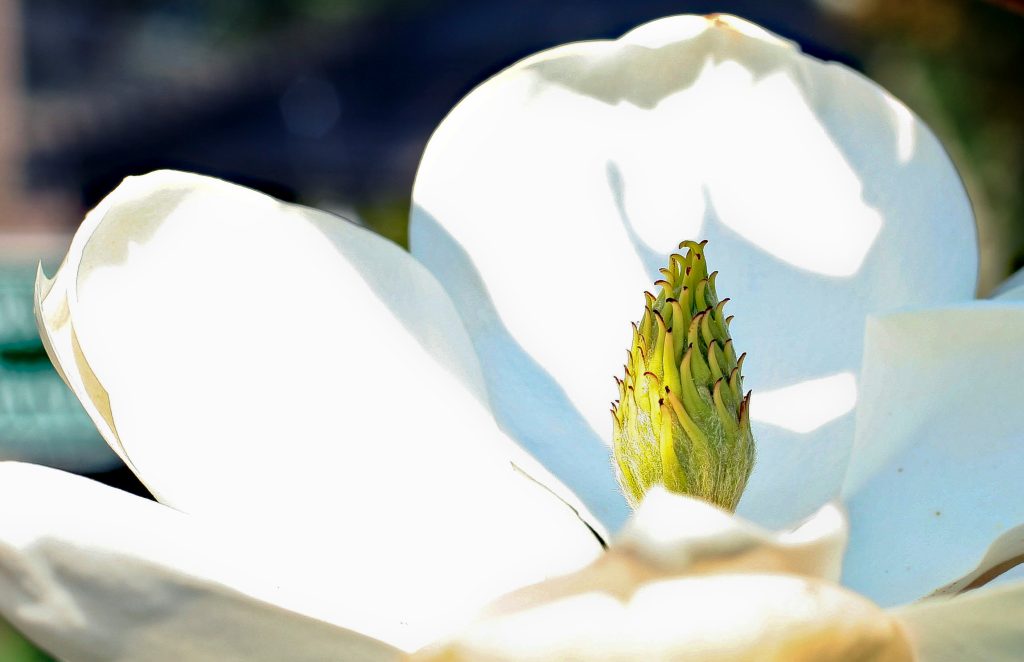
The native southern magnolia (Magnolia grandiflora) is a great native tree to plant in your landscape. Credit: Laura Ciociola.
Plant More Native Species
When thinking of new plantings or browsing the nursery, consider selecting native species for your landscape. Native species are more adapted to our native insects, diseases, soil conditions and climactic patterns. Native plants aren’t necessarily easier to grow – you still need to take care to get them well established – but they tend to be better able to handle the environmental stressors of our area. Additionally, native plants are most likely to benefit native wildlife species.
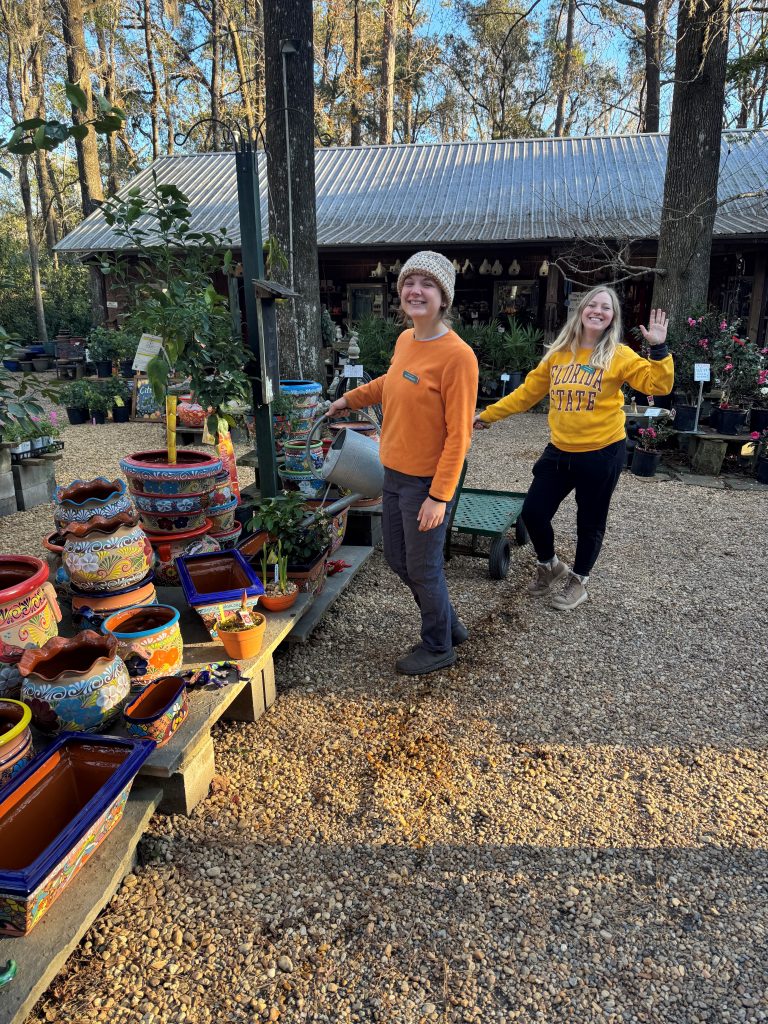
Local nurseries typically only offer plants well suited to your area and are your neighbors! Credit: Native Nurseries
Shop at Local Nurseries
When looking for those native plant species, try to support your local nursery businesses. Local nurseries tend to only carry the plants that are best suited to the area, and they’re your neighbors, too. To help find both native plant species and local nurseries, there is an association of Florida native plant nurseries (the Florida Association of Native Nurseries – FANN) that has a wonderful online search tool to find the perfect plant from the closest nursery.
Of course, don’t forget to utilize your local extension office if you decide to take on these resolutions. Whether it be help confirming that it is just a minor imperfection, help diagnosing a disease or insect problem, selecting native plant species, and or finding a local plant nursery, your local extension office can lead you in the right direction. UF/IFAS Extension’s Gardening Solutions webpage and Florida-Friendly Landscaping™ Program site also have plenty of online resources to help you have another successful and sustainable gardening year.
Happy New Year and Happy Gardening!
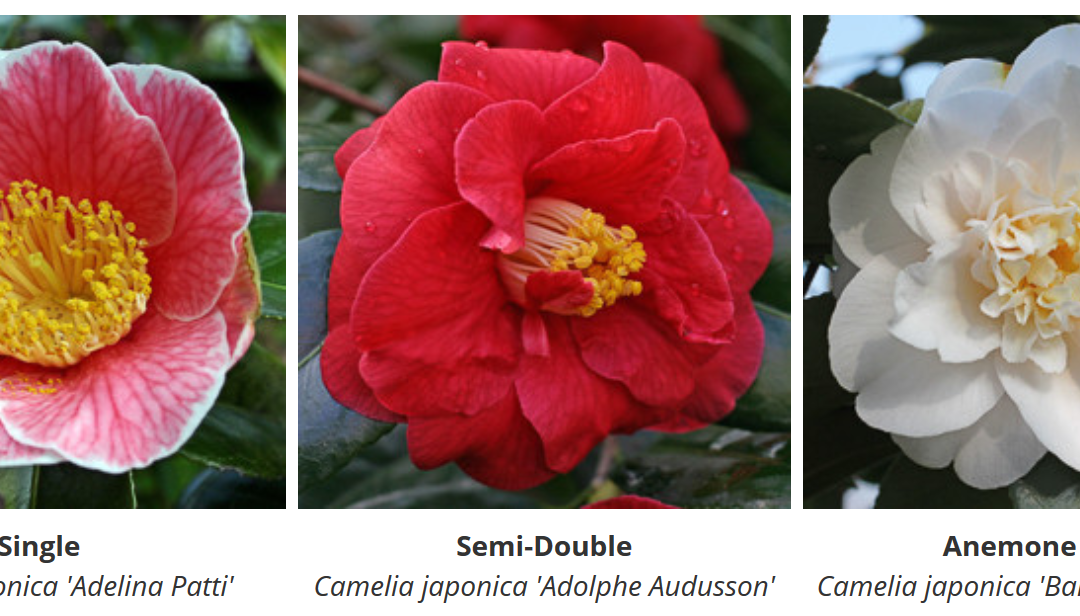
by Sheila Dunning | Jan 9, 2025
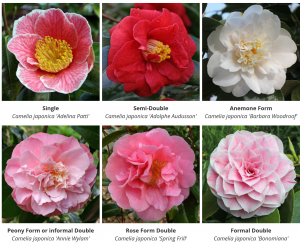 Camellias have been a part of the landscape in the Southeastern United States for over 200 years. They are native to Asia and were introduced near Charleston, South Carolina in 1786. The common name camellia refers to varieties and hybrids of Camellia japonica and to lesser known varieties of C. sasanqua and C. reticulata. The growing conditions in Northwest Florida are well suited for many camellia varieties. Camellias can serve several functions in the landscape including foundation plantings, screens, accent plants, background groupings and hedges. Maximum benefit can be achieved by mass plantings or groupings. Single plants should be focal point in beds rather than randomly placed throughout the lawn. Camellias flower in the fall and winter when their display of colorful blooms is most appreciated. During the remainder of the year their evergreen foliage, interesting shapes and textures, and relatively slow growth make camellias excellent landscape plants. Some camellia growers enjoy competing in flower shows and manipulate the flower buds to achieve larger and earlier flowers. This involves removing competing flower buds and applying gibberellic acid (a plant hormone). Individual cultivars can be selected for size and form ranging from small and irregular to large and upright. Texture and foliage color also differ among the various species and multiple varieties. Midseason flowering varieties that bloom from November through January are best suited for Florida conditions. Warm fall temperatures may prevent early varieties from flowering properly. Late-blooming selections may attempt to send out new leaves before the end of the flowering period which results in “bull
Camellias have been a part of the landscape in the Southeastern United States for over 200 years. They are native to Asia and were introduced near Charleston, South Carolina in 1786. The common name camellia refers to varieties and hybrids of Camellia japonica and to lesser known varieties of C. sasanqua and C. reticulata. The growing conditions in Northwest Florida are well suited for many camellia varieties. Camellias can serve several functions in the landscape including foundation plantings, screens, accent plants, background groupings and hedges. Maximum benefit can be achieved by mass plantings or groupings. Single plants should be focal point in beds rather than randomly placed throughout the lawn. Camellias flower in the fall and winter when their display of colorful blooms is most appreciated. During the remainder of the year their evergreen foliage, interesting shapes and textures, and relatively slow growth make camellias excellent landscape plants. Some camellia growers enjoy competing in flower shows and manipulate the flower buds to achieve larger and earlier flowers. This involves removing competing flower buds and applying gibberellic acid (a plant hormone). Individual cultivars can be selected for size and form ranging from small and irregular to large and upright. Texture and foliage color also differ among the various species and multiple varieties. Midseason flowering varieties that bloom from November through January are best suited for Florida conditions. Warm fall temperatures may prevent early varieties from flowering properly. Late-blooming selections may attempt to send out new leaves before the end of the flowering period which results in “bull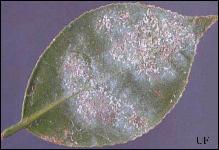 noses”. Bullnosing is characterized by poor quality flowers which do not open fully and may even drop while still tight buds. Extended dry periods while in the bud stage can make the condition more likely. While flowering, camellias need 1 inch of water applied each week. Camellias perform best in partially shaded locations which are enhanced by good drainage and air movement. Fertile, acidic soils high in organic matter are preferred. The soil must be well drained because camellias will not grow in wet areas. Do not plant them in areas with a high water table and/or hard pan. This will result in a shallow root system which is more susceptible to injury during dry periods. Camellias should be installed where cold air can move in and out freely, but the area should be protected from strong northwest winds. Plantings under established trees or in areas that have structures to block the wind are usually injured less by cold temperatures. These conditions enable the plants to gradually thaw or warm in the morning before being exposed to direct sunlight. Dense shade may result in sparse foliage and poor flowering. Camellias exposed to full sun may appear yellow-green, but may yield more flowers. Either situation is stressful to the plants and can lead to pest problems. Tea scale is the most common insect on camellias. Scales generally feed on the underside of leaves and may not be noticed until large populations have developed. Symptoms include very small elongated white and/or brown raised “flakes” on the underside of leaves that turn yellowish in color.
noses”. Bullnosing is characterized by poor quality flowers which do not open fully and may even drop while still tight buds. Extended dry periods while in the bud stage can make the condition more likely. While flowering, camellias need 1 inch of water applied each week. Camellias perform best in partially shaded locations which are enhanced by good drainage and air movement. Fertile, acidic soils high in organic matter are preferred. The soil must be well drained because camellias will not grow in wet areas. Do not plant them in areas with a high water table and/or hard pan. This will result in a shallow root system which is more susceptible to injury during dry periods. Camellias should be installed where cold air can move in and out freely, but the area should be protected from strong northwest winds. Plantings under established trees or in areas that have structures to block the wind are usually injured less by cold temperatures. These conditions enable the plants to gradually thaw or warm in the morning before being exposed to direct sunlight. Dense shade may result in sparse foliage and poor flowering. Camellias exposed to full sun may appear yellow-green, but may yield more flowers. Either situation is stressful to the plants and can lead to pest problems. Tea scale is the most common insect on camellias. Scales generally feed on the underside of leaves and may not be noticed until large populations have developed. Symptoms include very small elongated white and/or brown raised “flakes” on the underside of leaves that turn yellowish in color.
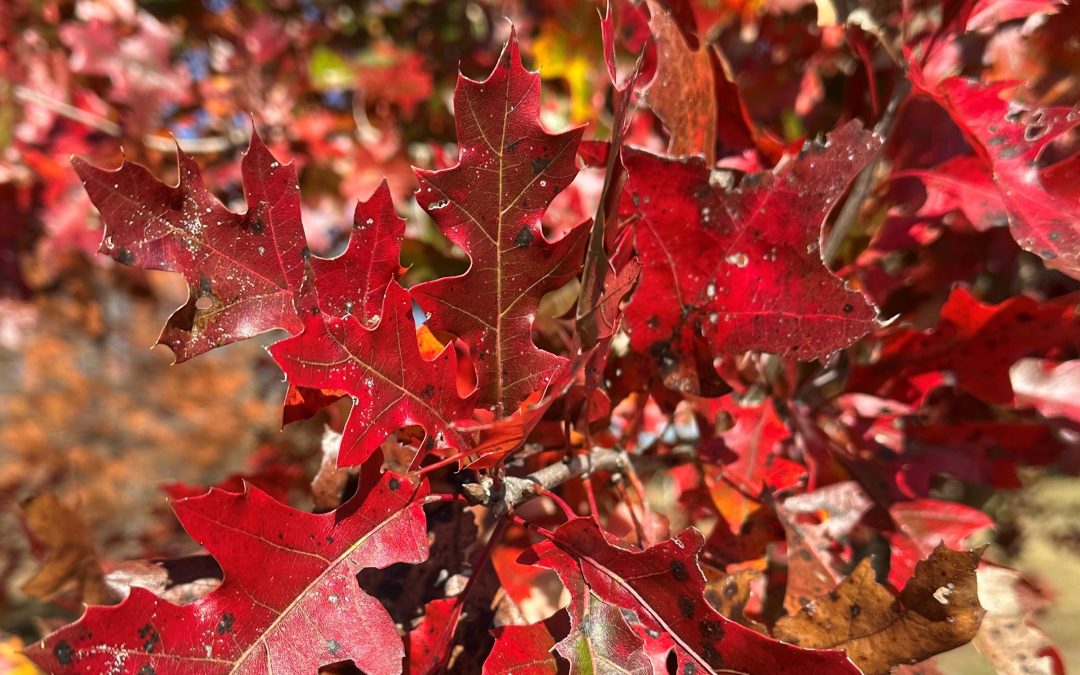
by Daniel J. Leonard | Jan 9, 2025
The Panhandle isn’t known for its fall foliage. The best we can normally hope for are splashes of pale yellow amidst a sea of green pine needles, drab brown leaves killed by the first frost, and invasive Chinese Tallow trees taunting us with vibrant colors we know we shouldn’t have. However, in 2024, you’d be forgiven if you forgot you were in Florida and had instead been transported to a more northern clime where leaves everywhere turned brilliant shades of yellow, orange, purple, and red. I’ve heard comments from many folks, and I agree, that this is the best fall color we’ve seen here in a long time – maybe ever. So, why were the leaves so pretty this past year? Let’s dive in.
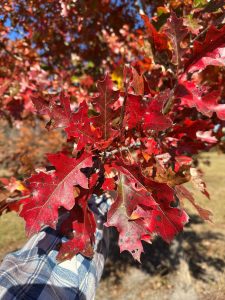
Shumard Oak displaying brilliant red fall foliage. Photo courtesy of Daniel Leonard.
What causes leaves to change colors in the fall?
First, what makes leaves of deciduous trees/shrubs (plants that shed their leaves in the winter) change color in the first place? The primary driver of leaf color change is daylength. During the summer, leaves appear green due to the presence of chlorophyll, which reflects green light, absorbs red and blue light, and is responsible for photosynthesis. When days shorten in the fall, plants sense that winter is coming and produce hormones that signal leaves to shut down chlorophyll production. They then initiate construction of a “wall” of cells that seals leaves off from the rest of the plant. When this happens, existing chlorophyll is “used up”, sugars build up in the now sealed off leaves, and other compounds that give leaves color, anthocyanins and carotenoids, take center stage. These compounds allow leaves to exhibit the familiar autumnal hues of yellow, red, orange, purple, and brown. However, plants go through this physiological process of shutting down growth and shedding leaves every year and excellent fall color. What we experienced this year, doesn’t always result. There has to be more to the fall 2024 story.
Why were leaves so pretty this year?
A second factor is required for a great fall foliage show – weather. According to the U.S. Forest Service, ideal temperature and moisture conditions must be met for leaf color to be its most intense. Ideal autumn conditions include warm (but not hot) sunny days with cool (but not freezing) nights and adequate (but not excessive) moisture. Too hot and plants become stressed, lessening fall color potential. Too cold, and frost can kill foliage – turning it immediately brown and preventing color development. Too rainy or windy, and leaves can be blown off prematurely. 2024 brought neither extremely hot, extremely cold, or extremely wet conditions, and we were blessed to experience a Goldilocks fall color season.
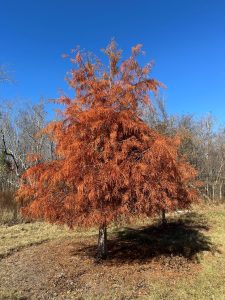
Bald Cypress with trademark burnt orange color. Photo courtesy of Daniel Leonard.
Did Some Trees Have Better Color than Others?
While pretty much all deciduous trees exhibited their peak color potential this year, there were definitely standouts! Fortunately, many of the prettiest trees this fall also make outstanding landscape trees. Be on the lookout for the following trees in nurseries this winter and consider adding a few to your yard to take advantage of the next Goldilocks fall color year:
- Red Maple (Acer rubrum) – brilliant red fall leaves.
- Florida Maple (Acer floridanum) – yellow/orange.
- Deciduous Oaks (Quercus spp) – generally red to purple. Some species like Sawtooth Oak ( acutissima) are yellow.
- Green Ash (Fraxinus pennsylvanica) – yellow.
- Swamp Tupelo (Nyssa sylvatica) – crimson to purple.
- Sweetgum (Liquidambar styraciflua) – highly variable but generally reds, oranges, and purples.
- Bald Cypress (Taxodium distichum) – burnt orange.
For more information about fall color, which trees and shrubs produce great fall color and perform well in landscapes, or any other horticultural topic, contact your local UF/IFAS County Extension office. Happy Gardening!

by Matt Lollar | Jan 2, 2025
It’s a new year and if you’re still contemplating resolutions, here’s one for you. Stay organized with your vegetable planting schedule. Since it’s January, let’s start with what you can do now. Crops like beets, broccoli, and Brussels are best planted as transplants in January. But carrots and celery can be started from seed and potatoes can be planted as seed potatoes, which are usually pieces of potato tubers containing at least 3 buds (eyes). January is also a good time to start transplants indoors for the spring garden. Tomato and pepper transplants can be planted in the garden as early as February or March depending on the year. If all this planting talk is overwhelming, then at least consider collecting and mailing off a soil sample for nutrient analysis. More information on soil testing can be found on askIFAS. This will give you a head start on adjusting pH with lime and improving soil health with compost and other organic materials. To help plan this “Year of the Vegetable Garden” please click below to enlarge the image of the handy “Florida Panhandle Planting Guide”.
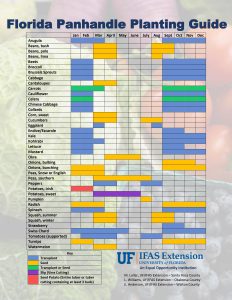
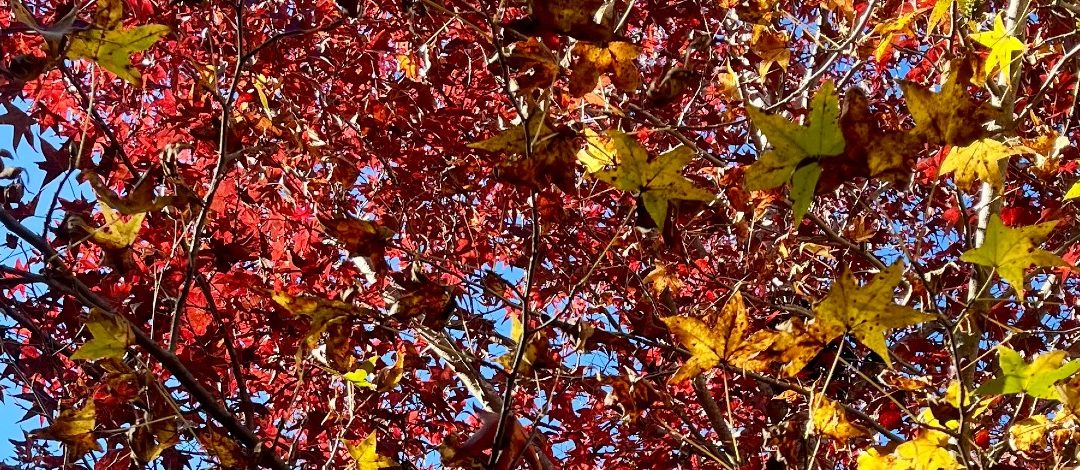
by Larry Williams | Jan 2, 2025
In the Christmas story as recorded in the book of Matthew, wise men presented gifts to baby Jesus. Two of these gifts were frankincense and myrrh. These are costly perfume oils derived from certain trees found in parts of the Middle East.
According to Dr. Kim Coder, urban forestry specialist with the UGA Extension Service, there are more than 36 trees mentioned throughout the Old and New Testaments. Some of these trees have relatives living here in Florida.
In an article on this topic, Coder said, “The trees most people think of from the Bible are the Cedars of Lebanon.” Lebanon cedars are true cedars like the Deodar cedar found planted in some North Florida communities. He said, “Today a relict (species of an earlier time) grove of 400 trees still survives on Mount Lebanon that is more than 2000 years old.”
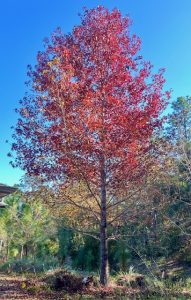
Sweetgum tree fall foliage at Okaloosa County Extension Office. Credit: Larry Williams
The sycamore common to North Florida does not grow in Palestine. “The sycamore of the Bible is the sycamore fig,” Coder explained. The fruit of the sycamore fig is smaller and less sweet as compared to the table fig and was considered food for the poor. Another name used by some people in the United States for sycamore is plane tree but Coder said that the plane trees referred to in the Bible were the flowering viburnums and oriental plane trees in the Middle East. “Also mentioned is the sycamine, which is the black mulberry,” Coder said.
The poplar trees of the Bible are the same white poplar that you can find growing in some areas of North Florida but it is more commonly found north of Florida. “But poplar also means
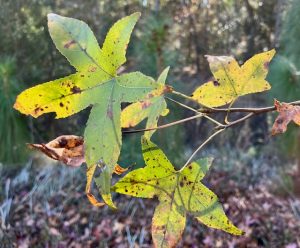
Sweetgum star-shaped leaves in fall. Credit: Larry Williams
snowbell, which is related to our native snowbells,” Coder said. “The name poplar was used for two distinctly different trees.”
One tree from the Bible that is common in North Florida is balm. “The balm, or balm of Gilead, was the sweetgum tree,” Coder said. The sweetgum of the Middle East is almost identical to our sweetgum tree that grows all over North Florida. Coder said that there is a tree named “Balm of Gilead” that grows in the northern United States but it is native only to North America. “Our sweetgum is a botanical link to the sweetgum of the Bible,” he said.
Ebony wood, which is also mentioned in the Bible, was imported for carvings and decorations. “Ebony is related to our common persimmon,” Coder said.
Florida’s forests are filled with close relatives of a number of Biblical trees. “There are many links to our cultural heritage stemming from the Bible,” Coder said. “Touch a sweetgum leaf and you hold a piece of Christian and Jewish history.”















